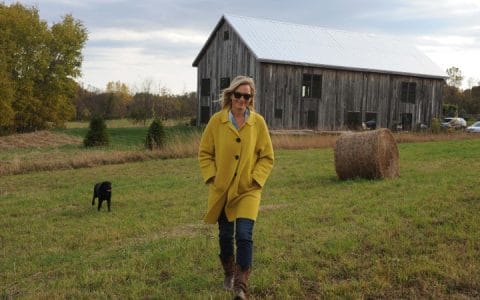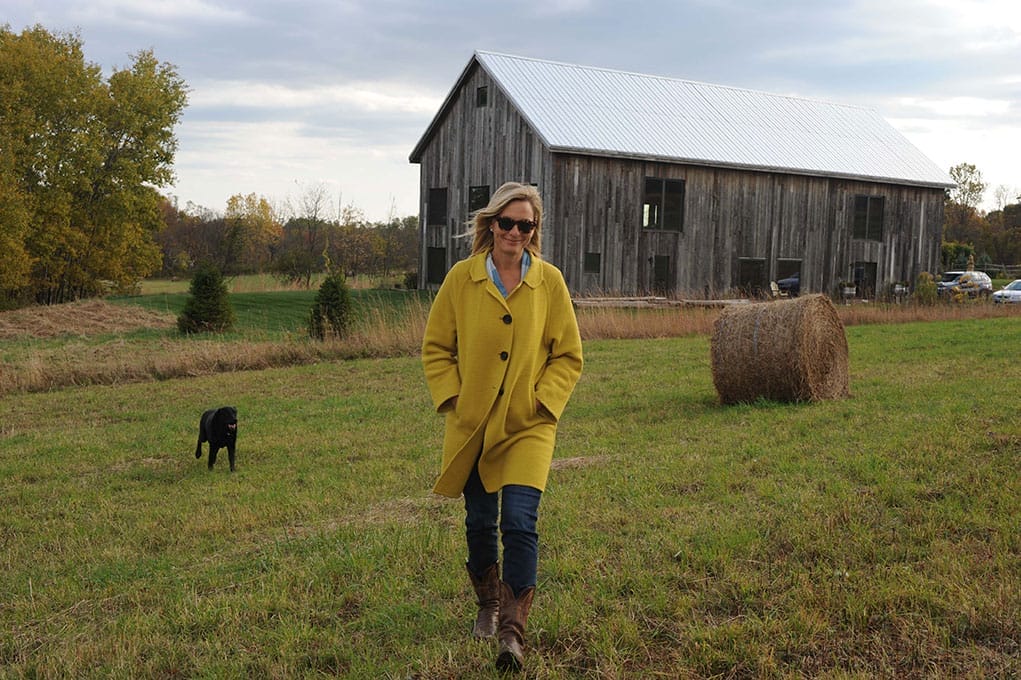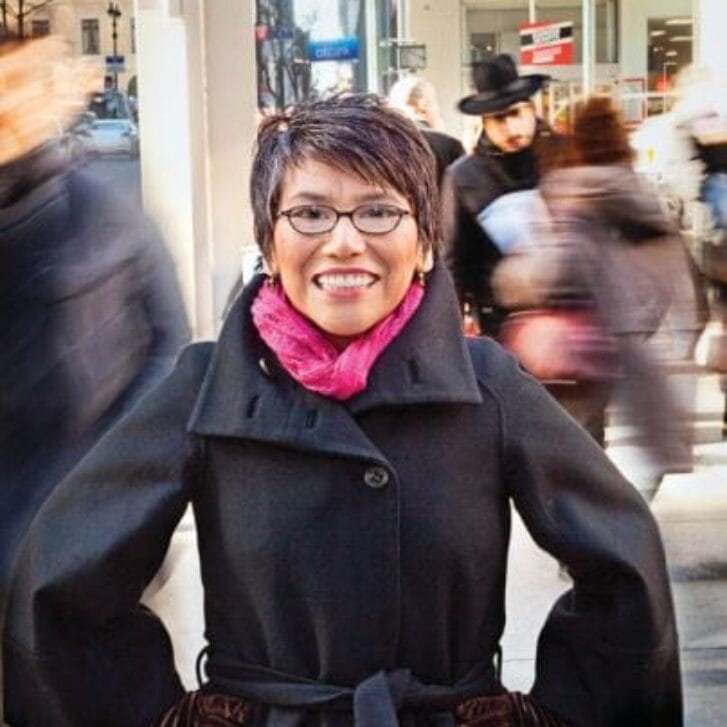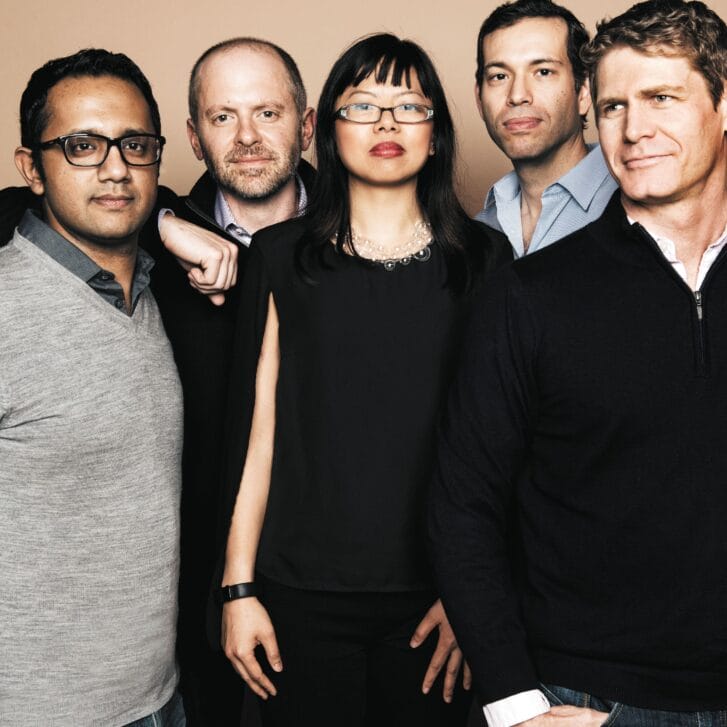At any one time, Cynthia McVay, G’88, WG’88, has 10 to 15 ideas in her head and about five major projects underway. Artwork she wants to create.
“Then one day, I just wake up and I have to do it,” she says. “I can’t not do it.”
One of her most recent, large pieces is “Human Sundial Project #3,” which she completed over the course of one day in New York’s Hudson Valley. She started at 6 a.m. on the summer solstice with her first subject—herself—standing in the center of a 15’x30’ canvas that she oriented east-west with a compass. After spray-painting her shadow, McVay traveled to another destination and asked a stranger to “stand” for the next hour. McVay did this every hour on the hour. By the end of the day, the spray-painted shadows across the canvas looked like “a huge piece of calligraphy,” she says. The final artwork includes photographs of the people who stood for each hour, along with their names, locations and occupations, and some of what they said in the moment.

“It’s a portrait of the sun through the day, and it’s also a portrait of the Hudson Valley,” McVay explains.
A disciplined, random portrait. Because after each hour and each spray-painting, she folded the canvas and drove off, never sure where she would stop for the next hour’s work and whom she might find.
“It was like what I used to do with my monkeys in the Amazon—taking samples in increments—an approach that also worked on a project or two at McKinsey,” she adds.
Human sundials, monkeys, McKinsey and the Amazon. We would fail if we tried to draw a straight line through those points. Sure, McVay’s many accomplishments, professions and pursuits—art, athletics, writing, historic renovation, consulting, innovation, nonprofit work, public service, academic research— have come one after the other, but her life is more a weave of patterns that come, go and come again, tying together her past, present and what lies ahead. Don’t expect her to know exactly what is next in life. Don’t expect that kind of Whartonite long-term plan. And don’t typecast her. Though if we must distill her life into a takeaway, it’s that she’s a leader who makes those around her ponder, smile and succeed.

Building and Innovating
Human Sundial Project #3 fits perfectly into the massive, 200-year-old barn that she moved onto her 82-acre Hudson Valley property, a place her daughter named Field Farm. The barn is “minimalist and very green,” solar passive and superinsulated, with breathing room and 35-foot ceilings. She estimates the space is equivalent to 8,000 square feet, her annual fuel bill at $700.
Attracted to its clean lines, she credits the Amish with designing the barn, although she made it livable and served as general contractor during its renovation. Her daughter Tess hung the first piece of furniture—a swing—in the center of the cathedral-like space.
“The barn itself is probably my biggest art project to date— and it’s filled with art,” she says. “I think my two summers in the Amazon were the inspiration for living so close to nature and in the land. Without that connection, I think I would get ‘nature deficit disorder’.”
More on the Amazon later, but first we have the Peace Corps. For as the barn was completed and art hung, McVay felt another urge—for public service. Soon after President Barack Obama’s historic first presidential election, she submitted her resume to the administration’s “50,000-resume pile.” A year later, as she tells it, the White House called her with:
“Are you still interested in coming to Washington?”
View them: See more of Cynthia’s Hudson Valley abode in our digital photoset.
They asked whether she would want to head the first-ever Office of Innovation for the Peace Corps. It struck her as an “oh god, that’s a title made for me” position. She went to the panel interview, was offered the job and waited for the background checks to come through. All the while, the most difficult decision she ever had to make confronted her. She had a life in New York, a penthouse apartment next to the Met designed by the eminent architect Ward Bennett, and her weekend getaway in Field Farm. Tess was going to be a junior in high school. It would be a major upheaval. But public service called.
“I wanted to serve my country, and I couldn’t imagine a better opportunity to do it,” she says.
To Washington, D.C., they went in Aug. 2010. Overall, she boils down her Peace Corps role as being an in-house consultant. She touched nearly all of the Peace Corps’ major operating processes with the aim of improving the institution’s effectiveness and efficiency. McVay was part of the President’s Innovation Cohort as well, which met monthly to bring together innovation-geared minds within other federal agencies, along with the nation’s technology and information systems czars.
One project encapsulates her time there: the “hackathon.” The Office of Innovation asked Peace Corps volunteers which new apps they could use in the field to help them work with their counterparts. At home base, McVay and team culled them, fleshed them out, then took the concepts to software engineers— collaborating with the worldwide hackers of Random Hacks of Kindness and at Harvard and MIT, where, in a 48-hour “hacking” marathon, apps were created.
She proved herself right; innovation director was a fitting role. Given her skills and background, why would we doubt it? She’s been working in strategy and innovation for a quarter-century— seven years with McKinsey, a dozen on her own, as vice president of Woolworth Corporation in a turnaround operation, and almost three years with Peace Corps—and throughout, she has always been the creative thinker, the person brought in to “see things in a completely different way.”
She laughs when she tells this. “I just don’t think normally. And I guess I am willing to take risks.”
But she insists it’s unflagging curiosity, the need to understand how things work, challenging assumptions, and the ability to make new connections often across departments or fields, that drives innovation.
McKinsey and the Monkeys
“Hypothesis-driven research” is what drives problem-solving, according to McVay.
“I rarely worked past 7 p.m. at McKinsey,” she adds to illustrate its power.
Both at McKinsey, in her own practice and in contracting, McVay likes to get her hands on the data or get the “texture” by interviewing the client up and down the chain of command. Often, she finds that the problem needs to be reframed.
Carter Bales, who knew McVay in the New York office where he served as director of McKinsey from 1978 to 1998, tells us that the two tests for anyone at McKinsey are: Will you become a great problemsolver, and will you become a great leader?
“She is highly gifted in both,” says the man whom McVay considers a mentor. “Interesting investing opportunities would flow to her because she is so powerfully magnetic as a human being.”
(McVay thanks McKinsey and a long list of mentors there for what they instilled in her: client first, integrity and fact-based analysis.)
If we rewind a little further, to the start of her McKinsey tenure, success did not appear guaranteed. McVay beams about it now when she recalls that it seemed McKinsey didn’t know what to do with her after they hired her. The firm liked her enough, but she was first assigned on a “sort of nonprofit” assignment.
After a year, a partner took a chance on her. She had a good enough run with him over the next two years to become “quality material” in the New York office. Things changed. She got some plumb assignments over the next five years, mostly all within walking distance of the New York office.
The question we should ask her is: Did becoming quality material coincide with her growing out her hair? You see, when she attended Wharton, she cropped her hair close. She wore paint-splattered clothes from art class to finance.
As was customary then, the McKinsey selection process was rigorous—13 interviews rigorous. Her peers wondered how she, not their typical Whartonite, scored what they coveted: a McKinsey job. They asked: What did she say during those interviews? How did she answer those usual interview questions? Like:
“What do you plan to be doing in five years?”
Her answer then: “I don’t know.”
The reason she got the McKinsey job, as she told her classmates then and she tells us now, must have been “those monkey vocalizations.”
“Which monkey vocalizations?” her classmates asked.
The monkey vocalizations she studied in the Peruvian Amazon, and upon which she based her 1983 undergraduate biology thesis at Harvard. One of her McKinsey interviewers asked about her thesis, and in explaining her vocalization study, McVay demonstrated the alarm and mating calls. Out loud.
“I was always a problem-solver at heart. Biology was about hypothesis-based inquiry. Same with McKinsey. It was about going in and seeing things and pulling disparate pieces of information and making sense of it—crunching the numbers and finding the logic,” she says, letting us know it’s not all about monkey calls.
Arranged and Educated
It was also in the Peruvian Amazon where she was first married technically. Her research camp was the kind of remote that requires a 25-hour trip in a lumber truck on a road over two sierras in the Andes that’s open in one direction Monday, Wednesday, Friday, and the other direction on Tuesday, Thursday, Saturday, followed by a two-day trip in a dugout canoe.
One night during the three-month stay at the field station, she heard what she thought was a jaguar outside her tent. The next morning, she told her colleagues and the park guard who happened to be visiting camp.
“No, no, no, that was your husband,” the guard told her.
“My husband?” she replied.
“Yeah, I married you off to a 13-year-old. You’re his fourth wife. I traded you for a flashlight,” the guard said.
Her 13-year-old husband belonged to a clan of Machiguenga Indians, nomads who visited McVay’s camp for a week in hopes of getting medicine to cure the common cold that killed some of their people.
Despite experiences like that, or because of them, McVay returned to the Amazon the following summer with her own funds and her own research—the monkey vocalization work—to complete her thesis.
What followed was years of specializing in Latin America. She worked as an author on the first edition of Let’s Go: Mexico after Harvard. Then by age 23, she became senior program officer of Mexico and Guatemala for the World Wildlife Fund, during which time she helped establish the well-known monarch butterfly reserve in Mexico and, perhaps more humdrum, took the WWF through its first-ever five-year strategic plan. Then she enrolled in Penn’s MBA/MA Lauder Joint-Degree in International Studies with a focus on Brazil.
Yes, we return to Wharton. McVay knew of Lauder because her sister, Catherine McVay Hughes, WG’87, was in Wharton’s MBA Program. McVay was attracted to the master’s in international studies but thought she might as well get a Wharton MBA while she was at it. Before we accuse young McVay of pooh-poohing Lauder’s world-class dual-degree program, let us note that she passed on Harvard Business School for the opportunity.
At Wharton, she was, as we’ve said, nonconventional. Was she always like that, we could ask her. As a young student, every honor her Princeton Catholic school could bestow flowed her way. She excelled as much at theater as she did in field research and academics as a Harvard undergrad. At Wharton, however, she was turned down by the Follies her first year. Her second year, she became director of choreography.
“I love to dance but really had no credentials,” she confesses.
Despite her difference, McVay possessed at Wharton the power of charisma and clarity of mind that have allowed her to succeed in all her endeavors, past, present and upcoming.
Katherine D’Urso, G’88, WG’88, became a lifetime friend of McVay after bonding at School over their love of “energetically” and at times “outrageously” public dancing. D’Urso does not state that McVay struggled with standing out at Wharton. But D’Urso cites the theory that says we become more ourselves as we age. McVay, she theorizes, has grown better able, more willing, to leverage her independent thinking and strong will.
“She is whole-brained,” D’Urso says of McVay’s ability to think on a grand, artistic scale and yet be organized and analytical— adding: “She has a strong streak of goofball in her.”
Another lifelong Lauder friend, Karen Karp, G’87, WG’87, shares first impressions of McVay: interesting, fun, worldly, curious, talented. Karp, director of international marketing for Christie’s specialty groups, has gone on to hire McVay as a consultant on multiple occasions (at the Metropolitan Opera and the Asia Society, for instance). McVay possesses an “exceedingly” creative approach to branding and retail, Karp says, and Karp values McVay for her ability to bring along skeptics, to grasp and see through big projects.
It is probably all that combined that endears her to whomever she meets, like the future chairman of Proctor & Gamble. McVay recalls one Lauderera dinner during which she sat beside Proctor & Gamble’s then-international head, Ed Artzt. They hit it off.
“I had absolutely no hair, but by the end of the dinner he asked me to be in a shampoo commercial,” she says.
A week or so later, she interviewed on campus with P&G on a whim. The interviewer closed down the interview when McVay confessed she had no idea why she would want to be a brand manager, that instead she wanted to work with Artzt in Latin America. Two days later, P&G frantically called to apologize and ask if she would talk with them about opportunities.
She ended up at McKinsey, later launched her own consulting practice, served the Peace Corps, lit into “The Human Sundial Project #3,” and refurbished the barn in Hudson Valley, where she now lives full time.
If we must distill her life into a takeaway, it may be that McVay has attracted and embraced more opportunities— simultaneously—than most people stumble upon in a lifetime.
That leaves us all asking: What is next? More real estate adventures? She bought a second Upstate New York property— including a home allegedly built in 1727 that served as a site for the New York State Assembly, another huge barn, a stone smokehouse and chicken coop—which she renovated and currently rents. Perhaps more art? She writes a poem a week, and is working on a book. Or making a film out of one of the five screenplays she has written? Perhaps consulting? Her private practice has resumed post-Peace Corps, reports Bales (who hopes to hire her away to his current firm, NewWorld Capital Group). Or maybe animal husbandry? She lists her profession on her LinkedIn page as “future goat herder.”
“Yes, the goats are a great alternative to a tractor—and greener,” she says, but she also eyes a sustainable, goat-based business model. If so, she may need to hire someone to watch the goats. Or learn herself how to make goat calls.
Whatever her next steps, in whatever order, McVay will lead where we all might want to go—where we’re happiest at that particular moment.
[well]
More Cynthia McVay Threads
Parents: Scott McVay, founding executive director, Robert Sterling Clark Foundation and Geraldine R. Dodge Foundation, poet, cetologist; Hella McVay, Berlin-born, D&R Greenway Land Trust (formerly on board), Whole Earth Center (co-founder, formerly on board); Young Audiences; Planned Parenthood (volunteer)
Daughter: Tess Krasne, Class of 2016 at Washington University, studying environmental biology, anthropology and economics; athlete, artist, dancer
Education: Stuart School ’79 (Princeton, N.J.); Harvard University ‘83 (magna cum laude) Biology and Visual & Environmental Studies; Wharton/Penn ’88 (Brazil/Portugues)
Early leadership experiences: All-state/All-Star high school basketball player on state championship team; high school lacrosse referee at age 15; editor, Thistle, high school literary magazine
[/well]


























